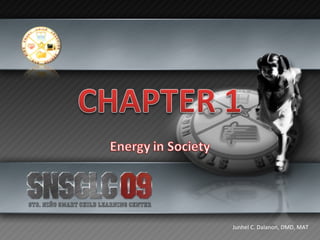Energy in Society
•Als PPT, PDF herunterladen•
0 gefällt mir•479 views
The document discusses several topics in science including branches of science such as physics, chemistry, biology, earth science and environmental science. It provides biographies and contributions of several important scientists such as Aristotle, Galileo, Newton, Faraday, Maxwell and Einstein. Key concepts in physics discussed include Newton's laws of motion, Maxwell's electromagnetic theory, Einstein's theories of special and general relativity, and Max Planck's work on quantum theory.
Melden
Teilen
Melden
Teilen

Empfohlen
Empfohlen
Weitere ähnliche Inhalte
Was ist angesagt?
Was ist angesagt? (20)
Experimental & Theoretical Evidences of Fallacy of Space-time Concept and Act...

Experimental & Theoretical Evidences of Fallacy of Space-time Concept and Act...
Ähnlich wie Energy in Society
Ähnlich wie Energy in Society (20)
Dhemy Fernandi ( 20171000011 ) Ilmu Alam by frederich Engels Chapter 9.

Dhemy Fernandi ( 20171000011 ) Ilmu Alam by frederich Engels Chapter 9.
A.1 Formation of Heavier Elements During the Star Formation and Evolution.pptx

A.1 Formation of Heavier Elements During the Star Formation and Evolution.pptx
Historical background on the development in chemistry iii

Historical background on the development in chemistry iii
Mehr von Junhel Dalanon
Mehr von Junhel Dalanon (20)
The Secularization Of Priests During The Spanish Period

The Secularization Of Priests During The Spanish Period
Kürzlich hochgeladen
Kürzlich hochgeladen (20)
Python Notes for mca i year students osmania university.docx

Python Notes for mca i year students osmania university.docx
Micro-Scholarship, What it is, How can it help me.pdf

Micro-Scholarship, What it is, How can it help me.pdf
ICT Role in 21st Century Education & its Challenges.pptx

ICT Role in 21st Century Education & its Challenges.pptx
This PowerPoint helps students to consider the concept of infinity.

This PowerPoint helps students to consider the concept of infinity.
HMCS Max Bernays Pre-Deployment Brief (May 2024).pptx

HMCS Max Bernays Pre-Deployment Brief (May 2024).pptx
ICT role in 21st century education and it's challenges.

ICT role in 21st century education and it's challenges.
Unit 3 Emotional Intelligence and Spiritual Intelligence.pdf

Unit 3 Emotional Intelligence and Spiritual Intelligence.pdf
HMCS Vancouver Pre-Deployment Brief - May 2024 (Web Version).pptx

HMCS Vancouver Pre-Deployment Brief - May 2024 (Web Version).pptx
Basic Civil Engineering first year Notes- Chapter 4 Building.pptx

Basic Civil Engineering first year Notes- Chapter 4 Building.pptx
Food safety_Challenges food safety laboratories_.pdf

Food safety_Challenges food safety laboratories_.pdf
Energy in Society
- 1. Junhel C. Dalanon, DMD, MAT
- 7. Chemistry
- 9. Physics
- 11. Astronomy
- 13. Earth Sciences Earth science (also known as geoscience , the geosciences or the Earth Sciences ), is an all-embracing term for the sciences related to the planet Earth. It is arguably a special case in planetary science, the Earth being the only known life-bearing planet. There are both reductionist and holistic approaches to Earth science. There are four major disciplines in earth sciences, namely geography, geology, geophysics and geodesy. These major disciplines use physics, chemistry, biology, chronology and mathematics to build a quantitative understanding of the principal areas or spheres of the Earth system.
- 14. Branches of Earth Science
- 15. Environmental Sciences Environmental science is an expression encompassing the wide range of scientific disciplines that need to be brought together to understand and manage the natural environment and the many interactions among physical, chemical, and biological components. Environmental Science provides an integrated, quantitative, and interdisciplinary approach to the study of environmental systems. Individuals may operate as Environmental scientists or a group of scientists may work together pooling their individual skills. The most common model for the delivery of Environmental science is through the work of an individual scientist or small team drawing on the peer-reviewed, published work of many other scientists throughout the world.
- 17. Biology
- 20. Aristotle
- 21. Aristotle Aristotle’s theory of the basic constituents of matter looks to a modern scientist perhaps something of a backward step from the work of the atomists and Plato. Aristotle assumed all substances to be compounds of four elements : earth, water, air and fire, and each of these to be a combination of two of four opposites , hot and cold, and wet and dry. (Actually, the words he used for wet and dry also have the connotation of softness and hardness). Aristotle’s whole approach is more in touch with the way things present themselves to the senses, the way things really seem to be, as opposed to abstract geometric considerations. Hot and cold, wet and dry are qualities immediately apparent to anyone, this seems a very natural way to describe phenomena. He probably thought that the Platonic approach in terms of abstract concepts, which do not seem to relate to our physical senses but to our reason, was a completely wrongheaded way to go about the problem. It has turned out, centuries later, that the atomic and mathematical approach was on the right track after all, but at the time, and in fact until relatively recently, Aristotle seemed a lot closer to reality. He discussed the properties of real substances in terms of their “elemental” composition at great length, how they reacted to fire or water, how, for example, water evaporates on heating because it goes from cold and wet to hot and wet, becoming air, in his view. Innumerable analyses along these lines of commonly observed phenomena must have made this seem a coherent approach to understanding the natural world.
- 24. Galileo Galilei
- 26. Johannes Kepler
- 28. Robert Boyle
- 30. Sir Isaac Newton
- 32. Benjamin Franklin & Michael Faraday
- 34. Count Rumford & James Prescott Joule
- 37. Augustin Jean Fresnel & Thomas Young
- 41. Albert Einstein & Max Planck
